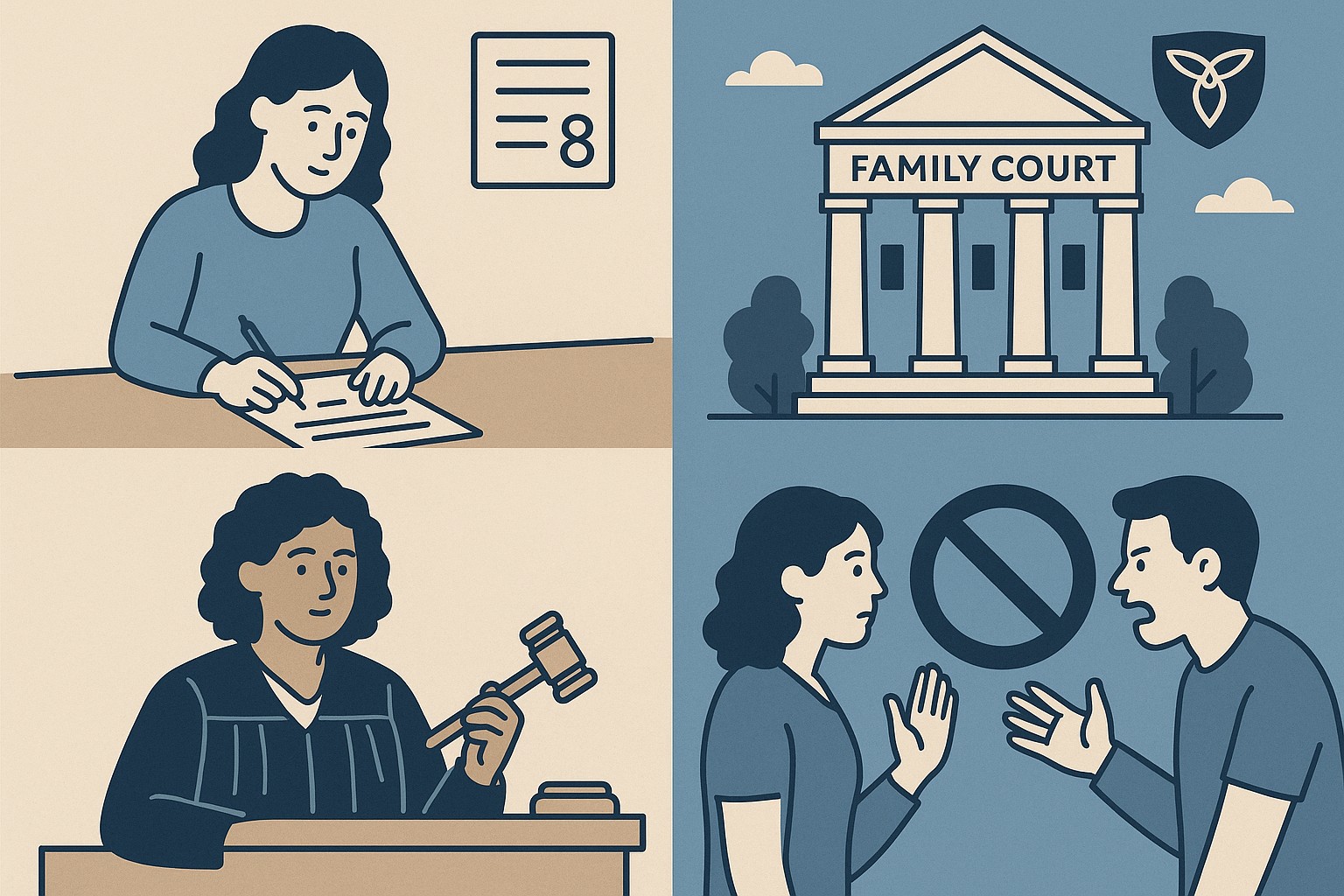How to Get a Restraining Order in Ontario Family Court Using Form 8
You can ask for a restraining order in Ontario Family Court by checking the box on your **Form 8: Application (General)**, but if you need protection now, you must take further action. Our guide explains the critical process of filing an **urgent motion without notice**. Learn how to prepare the crucial affidavit with your evidence, what to expect at the urgent hearing, and the steps to take after a judge grants a temporary order.

For family law cases in Ontario, checking the “restraining order” box in Part 5 of the Form 8: Application (General) is the official first step to ask the court for a protective order.
However, simply filing the Form 8 application can take weeks or months to be heard. If you have a genuine fear for your safety or the safety of your child, you need protection now. This requires taking additional, urgent steps alongside your main application.
This guide explains the entire process, from checking the box on Form 8 to the urgent motion required to get a temporary order in place quickly.
What is a Family Law Restraining Order?
A restraining order is a court order that sets limits on one person's contact and communication with another. It is a civil order, but a breach of its conditions is a criminal offense. A family law restraining order can require a person to:
- Not contact you or your children, directly or indirectly (including through social media or third parties).
- Stay a certain distance away from you, your home, your workplace, or your children’s school or daycare.
- Not harass, threaten, or bother you or your children in any way.
You can apply for one against a spouse, former spouse, or another parent if you have a genuine fear for your safety or your children's safety based on a pattern of abuse or threats.
The Process: From Checking the Box to Getting an Order
Getting a restraining order is a multi-step process. The Form 8 is the foundation, but the motion is what gets you urgent results.
Step 1: The Foundation – Your Form 8 Application
As you noted, the process begins with the Form 8: Application (General).
- In Part 5 (Claims for Relief): Check the box for "Restraining order."
- In Part 7 (Grounds): Briefly summarize the facts that support your request. You should clearly state that you are afraid for your safety due to the other person's actions or threats.
Step 2: The Evidence – Your Sworn Affidavit
The most important part of your request is your evidence. This is presented to the court in a sworn document called an affidavit (Form 14A). This is your testimony, written down. It must be detailed, factual, and honest.
Your affidavit should include:
- A clear history of the relationship and the abuse (physical, emotional, psychological, financial).
- Specific details: Use dates, times, and locations for all key incidents.
- Direct quotes: Write down exactly what was said during threats.
- Police Involvement: Note any time the police were called, including dates and police report numbers if you have them.
- Witnesses: Mention if anyone else saw or heard the incidents.
- Explain your fear: State clearly why these past events make you fear for your future safety or your children's safety.
- Attach Exhibits: Include copies of photos of injuries, screenshots of harassing text messages or emails, and copies of any police or medical records.
Step 3: The Action – Filing an Urgent Motion Without Notice
Waiting for your Form 8 application to be heard is not practical if you are in danger. To get an order quickly, you must file an Urgent Motion Without Notice (also called an ex parte motion).
This is a request to see a judge immediately without the other party being notified. You must convince the judge that the situation is so urgent that notifying the other person would put you or your children at immediate risk.
To file this motion, you will need to prepare a Motion Record, which includes:
- Form 14: Notice of Motion: States what you are asking for (a temporary restraining order without notice).
- Form 14A: Affidavit (General): This is your detailed, sworn evidence as described in Step 2.
What Happens at the Urgent Hearing?
You (or your lawyer) will go before a judge. The judge will read your Motion Record and may ask you questions about your affidavit. If the judge agrees that your situation is urgent and there is evidence of risk, they will likely grant a temporary restraining order.
This temporary order will only be in effect for a short time (often 10 to 14 days). The judge will schedule a second court date where the other party must attend.
After a Temporary Order is Granted
- Service: The temporary order and all your court documents must be formally served on the other party by another adult or a professional process server. This notifies them of the order and the next court date.
- Police Enforcement: You must take a copy of the signed order to your local police station (e.g., Toronto Police Service). They will enter it into their system so it can be enforced if the other party breaches the conditions.
- The Next Court Date: At the next hearing, both you and the other party will have a chance to speak to the judge. The judge will then decide whether to extend the restraining order, make it final, or terminate it.
Disclaimer: This is for informational purposes only and is not legal advice. Seeking a restraining order is a serious legal process. It is strongly recommended that you seek help from a family law lawyer. Contact the Law Society of Ontario's Referral Service or a local community legal clinic for assistance. If you are in immediate danger, call 911. For support, contact the Assaulted Women's Helpline at 1-866-863-0511.
